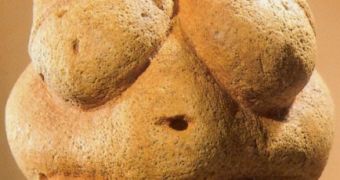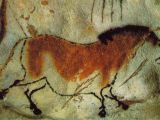Paleolithic is the period that makes most of our history. It started with the oldest known stone tools, 2.6 Ma ago and lasted until 10,000 years ago. It emerged with Homo habilis and reached its peak with our species, Homo sapiens, which appeared about 200,000 years ago.
It is the period when humans were just hunters-gatherers. Even if the name of the period referred to the stone tools, first people most likely made also tools from bones.
One of the main factors that modeled human evolution was the fire. The fire enabled people to get a heat source in cold climes and chase away predators. Homo ergaster, 1.9 Ma ago, could have been the first people to use fire. The bonfire was probably achieved from a lightning during a storm, a volcanic explosion or other accidental source. Later on, primitive people might have kept a torch or brands. It is hard to imagine how Neanderthals or Homo sapiens could have survived without fire during the Ice Age. The first stone tools were probably used as projectiles or to hit with them like with a mace. Later, the primitive humans observed that broken stones had cutting edges that could inflict deeper wounds or cut animals into pieces. Step by step, people learned to hit stone by stone to produce sharpened tools. The stone processing was used until the discovery of the metals by Homo sapiens, after the Neolithic.
Stone scrapers were used for removing the skins of the animals. Stone axes were used for wounding or cutting up the prey. They had handles made of wood or deer antlers. Stone drills were used too. The main stone raw material was the quartz. Wooden tools did not preserve in time.
During the Upper Paleolithic (40,000 to 10,000 BC), more complex stone tools appeared, like stone lamps that were filled with grease and had a wick made of plant fibers. The silex arrow points were complex, having rods that allowed them to be joined to the shaft via a resin or tendons. Bone harpoons and needles from this period were found in Europe.
The Paleolithic man seems to have been a hunter, while the women were charged with gathering. Sons were meant to turn into hunters later in their lives. Paleolithic people would live in hordes made of 2 or more families. In time, the horde turned into a tribe.
Death was omnipresent during the Paleolithic, and the mystery of life and death translated into the practice of the faith into a world of spirits and the practice of magical rites. Dead people in many cases were believe to turn into evil spirits that could harm the living (it was also a method to explain natural phenomena), and this is how the cult of the ancestors emerged. This cult was meant to appease the spirits of the dead.
The cult of the dead was mixed with magical rites meant to bring abundant game. In many cases, people danced, wearing the skins of the animal they wanted to hunt and masks mimicking those animals.
The group hunting and the power of the mind enabled the Paleolithic humans to hunt even huge animals, like mammoths, despite the weak human physic. Mammoths and woolly rhinoceros were hunted using trap holes with stakes on their bottom. Trapped mammals were finished using large stones. A mammoth could have allowed the survival of a horde during a winter of the Ice Age. Mammoth grease was used for lightning and heating.
Paleolithic people were also great artists; they left cave wall paintings in the whole Europe. They painted especially animals they wanted to bring down: horses, mammoths, reindeer, bisons; these paintings had a magic character, being meant for the capture of the represented animals. Probably, the painter was a shaman, endowed with magical powers. The drawings were made at the light of torches, firelighters and grease lamps. When the paintings were finished, the hunters came and shot their arrows at the represented animals, thus ensuring they would kill those animals in the real hunt. Animal figurines could have also had the same role, of bringing good hunt. The Paleolithic people also made many woman figurines, the so-called Paleolithic Venuses. All of them resembled rather Rubens' taste than modern designers'.
The Paleolithic was characterized by the existence of the megafauna, a fauna abundant in giant beasts, most of them extinct now, like giant sloths, mastodons, mammoths, saber-toothed cats, cave lions, cave bears, cave hyenas, horses, camels, giant deer, glyptodonts (giant armadillos), woolly rhinos. Today, some of the Earth's megafauna survive only in some African reserves.
Probably in time, the best hunter turned into a chief of the horde, then of the tribe. The chiefs were obeyed, and this way, hunting became better organized. People would organize hunt beating, carefully prepared by the chief and the most experienced hunters. Tasks were divided: some were beaters, others spear throwers. This way, Paleolithic people could drive herds of wild animals towards natural traps, where they were easier to hunt. Wild horses were chased towards a cliff, the way Ona people in Tierra del Fuego still hunt the guanaco (a wild camel). The wounded animals were finished off by the rest of the hunters, waiting at the bottom of the cliff.
The Paleolithic people had a nomadic life style, following the herds of wild animals they relied on. They extensively used caves for sheltering, but probably they also made tents of skins, sustained by sticks. They wore skins and adorned their bodies with stone beads and collars made of animal canines (which could have been protective amulets).
The hunter of the Upper Paleolithic employed bows and arrows, maces (for finishing badly wounded animals), javelins (with stone tips secured through animal ligaments).
Paleolithic societies survived up to our days in some places in Africa (Bushmen and pygmies), Australia (Aborigines), South America (like in Tierra del Fuego and other places).

 14 DAY TRIAL //
14 DAY TRIAL // 
